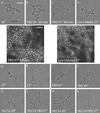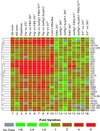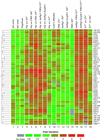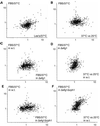Transcription profiling of Candida albicans cells undergoing the yeast-to-hyphal transition
- PMID: 12388749
- PMCID: PMC129958
- DOI: 10.1091/mbc.e02-05-0272
Transcription profiling of Candida albicans cells undergoing the yeast-to-hyphal transition
Abstract
The ability of the pathogenic fungus Candida albicans to switch from a yeast to a hyphal morphology in response to external signals is implicated in its pathogenicity. We used glass DNA microarrays to investigate the transcription profiles of 6333 predicted ORFs in cells undergoing this transition and their responses to changes in temperature and culture medium. We have identified several genes whose transcriptional profiles are similar to those of known virulence factors that are modulated by the switch to hyphal growth caused by addition of serum and a 37 degrees C growth temperature. Time course analysis of this transition identified transcripts that are induced before germ tube initiation and shut off later in the developmental process. A strain deleted for the Efg1p and Cph1p transcription factors is defective in hyphae formation, and its response to serum and increased temperature is almost identical to the response of a wild-type strain grown at 37 degrees C in the absence of serum. Thus Efg1p and Cph1p are needed for the activation of the transcriptional program that is induced by the presence of serum.
Figures






Similar articles
-
The serine/threonine protein phosphatase SIT4 modulates yeast-to-hypha morphogenesis and virulence in Candida albicans.Mol Microbiol. 2004 Feb;51(3):691-709. doi: 10.1111/j.1365-2958.2003.03879.x. Mol Microbiol. 2004. PMID: 14731272
-
Signaling through protein kinases and transcriptional regulators in Candida albicans.Crit Rev Microbiol. 2003;29(3):259-75. doi: 10.1080/713610451. Crit Rev Microbiol. 2003. PMID: 14582620 Review.
-
Cell cycle arrest during S or M phase generates polarized growth via distinct signals in Candida albicans.Mol Microbiol. 2005 Aug;57(4):942-59. doi: 10.1111/j.1365-2958.2005.04727.x. Mol Microbiol. 2005. PMID: 16091036
-
Transcript profiling of a MAP kinase pathway in C. albicans.Microbiol Res. 2008;163(4):380-93. doi: 10.1016/j.micres.2008.03.001. Epub 2008 May 8. Microbiol Res. 2008. PMID: 18467082
-
Regulation of Candida albicans Hyphal Morphogenesis by Endogenous Signals.J Fungi (Basel). 2019 Feb 28;5(1):21. doi: 10.3390/jof5010021. J Fungi (Basel). 2019. PMID: 30823468 Free PMC article. Review.
Cited by
-
Systematic Metabolic Profiling Identifies De Novo Sphingolipid Synthesis as Hypha Associated and Essential for Candida albicans Filamentation.mSystems. 2022 Dec 20;7(6):e0053922. doi: 10.1128/msystems.00539-22. Epub 2022 Oct 20. mSystems. 2022. PMID: 36264075 Free PMC article.
-
Variation in Candida albicans EFG1 expression enables host-dependent changes in colonizing fungal populations.mBio. 2012 Jul 24;3(4):e00117-12. doi: 10.1128/mBio.00117-12. Print 2012. mBio. 2012. PMID: 22829676 Free PMC article.
-
Regulation of the Cdc42/Cdc24 GTPase module during Candida albicans hyphal growth.Eukaryot Cell. 2005 Mar;4(3):588-603. doi: 10.1128/EC.4.3.588-603.2005. Eukaryot Cell. 2005. PMID: 15755921 Free PMC article.
-
Cold adaptation in budding yeast.Mol Biol Cell. 2004 Dec;15(12):5492-502. doi: 10.1091/mbc.e04-03-0167. Epub 2004 Oct 13. Mol Biol Cell. 2004. PMID: 15483057 Free PMC article.
-
Identification and characterization of Cor33p, a novel protein implicated in tolerance towards oxidative stress in Candida albicans.Eukaryot Cell. 2005 Dec;4(12):2160-9. doi: 10.1128/EC.4.12.2160-2169.2005. Eukaryot Cell. 2005. PMID: 16339733 Free PMC article.
References
-
- Ashman RB. Candida albicans: pathogenesis, immunity and host defense. Res Immunol. 1998;149:281–288. ; discussion 494–496. - PubMed
-
- Balciunas D, Ronne H. Yeast genes GIS1–4: multicopy suppressors of the Gal- phenotype of snf1 mig1 srb8/10/11 cells. Mol Gen Genet. 1999;262:589–599. - PubMed
-
- Bidard F, Bony M, Blondin B, Dequin S, Barre P. The Saccharomyces cerevisiae FLO1 flocculation gene encodes for a cell surface protein. Yeast. 1995;11:809–822. - PubMed
Publication types
MeSH terms
Substances
LinkOut - more resources
Full Text Sources
Molecular Biology Databases

